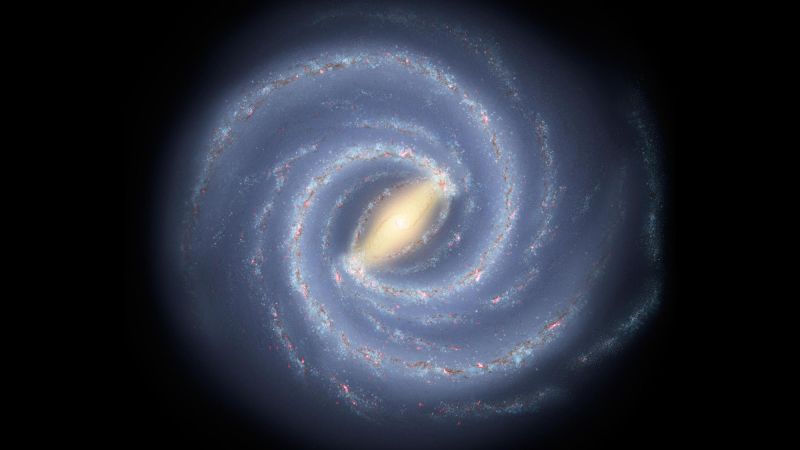
A collision between the Milky Way galaxy and its largest neighbor, the Andromeda galaxy, long predicted to occur in about 4.5 billion years, may not be as inevitable as once thought. New research published in the journal Nature Astronomy suggests that the probability of this cosmic event, often referred to as “Milkomeda,” is significantly lower than previously estimated.
For over a century, astronomers have anticipated this galactic clash, given that the Milky Way and Andromeda are racing towards each other at approximately 223,694 miles per hour (100 kilometers per second). However, a team of astronomers has now factored in the gravitational influences of other galaxies within the Local Group, a collection of over 100 smaller galaxies, to reassess the likelihood of such a collision.
Reevaluating Galactic Dynamics
The Local Group includes significant players like the Large Magellanic Cloud (LMC) and M33, also known as the Triangulum galaxy. By incorporating these into their models, researchers conducted 100,000 simulations using data from the Hubble and Gaia space telescopes. Their findings reveal only a 50% chance of a collision within the next 10 billion years, with a mere 2% likelihood of it occurring in the next 4 to 5 billion years, contrary to previous predictions.
According to study coauthor Carlos Frenk, a professor at Durham University, a merger between the Milky Way and Andromeda would result in the destruction of both galaxies, transforming them into a single elongated structure. Frenk explains,
“Until now we thought this was the fate that awaited our Milky Way galaxy. We now know that there is a very good chance that we may avoid that scary destiny.”
The Role of Smaller Galaxies
Simulations indicate that the gravitational pull of the LMC and M33 plays a crucial role in altering the Milky Way’s trajectory. The LMC, despite being only 15% the mass of the Milky Way, exerts a perpendicular force that reduces the likelihood of a merger with Andromeda. Similarly, M33’s mass slightly pulls the Milky Way towards it, further complicating the dynamics.
Lead study author Dr. Till Sawala from the University of Helsinki notes,
“The extra mass of Andromeda’s satellite galaxy M33 pulls the Milky Way a little bit more towards it. However, we also show that the LMC pulls the Milky Way off the orbital plane and away from Andromeda.”
Simulating the Future
In over half of the simulations, the Milky Way and Andromeda initially pass close to each other before potentially merging. These encounters involve interactions between their gaseous halos, which could eventually lead to a collision. However, in other scenarios, the galaxies cross paths without significant disturbance.
Geraint Lewis, a professor of astrophysics at the University of Sydney, finds the study’s insights into the gravitational effects of M33 and the LMC compelling. He remarks,
“We won’t know if the collision is definitely off in the future, but this clearly shows that the story that people tell — that there will be a collision that will destroy the Milky Way and Andromeda — is not as clear or certain that people think.”
Predicting Cosmic Outcomes
The study highlights the complexities of predicting galactic futures. Scott Lucchini, a postdoctoral fellow at the Center for Astrophysics, Harvard & Smithsonian, emphasizes the importance of accounting for uncertainties in galactic positions, velocities, and masses. He states,
“This really gives us the whole picture of what could happen in the future.”
Despite these uncertainties, the upcoming data from the Gaia space telescope, expected in 2026, may refine our understanding of Andromeda’s motion, potentially altering current predictions.
The Implications for Earth
While the cosmic dance of galaxies captivates astronomers, the future of Earth may be more directly impacted by the sun’s lifecycle. As our sun ages and expands into a red giant in about 5 billion years, it could engulf the inner planets, including Earth. Dr. Sawala notes,
“The short answer is that the end of the sun is far worse for our planet than the collision with Andromeda.”
Although the study did not model a detailed merger between the Milky Way and the LMC, it predicts a “virtual certainty” of such an event within the next 2 billion years. This merger is expected to have less dramatic effects than a collision with Andromeda but will still significantly impact the Milky Way’s structure.
As astronomers continue to unravel the mysteries of our galaxy’s future, these findings underscore the dynamic and uncertain nature of cosmic evolution. The fate of the Milky Way remains an open question, influenced by myriad factors both known and yet to be discovered.





